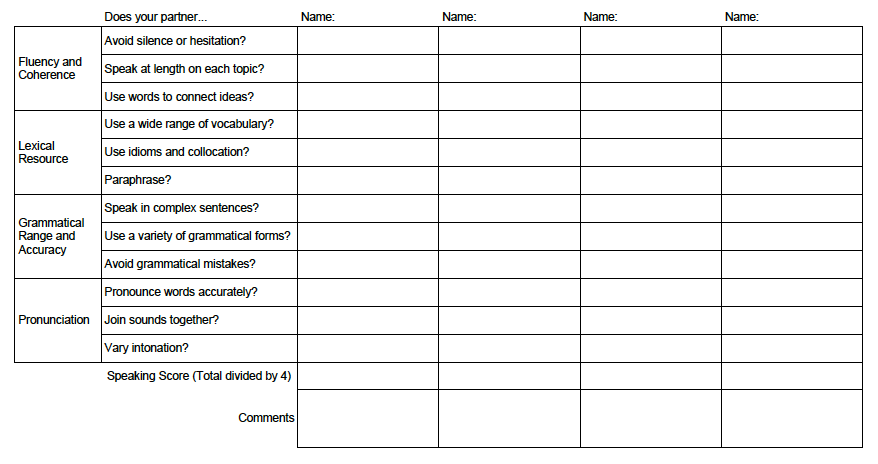 This article is part of the Teach IELTS series at IELTS Academic, an online provider of skills training for IELTS and English as a foreign language.
This article is part of the Teach IELTS series at IELTS Academic, an online provider of skills training for IELTS and English as a foreign language.
Are you looking for an easier way to calculate IELTS Speaking scores?
The assessment criteria for IELTS Speaking are publicly available, but the official document is not exactly classroom-friendly. Not only is the language filled with jargon, the complexity is so great that explaining it all in class would drastically reduce any speaking practice time available to students.
IELTS Academic has produced a simplified version of the IELTS Speaking scoring rubric that is faithful to the official version but designed to be more accessible for students. This IELTS Speaking Feedback Sheet organises the IELTS Speaking assessment criteria into 12 basic attributes. Try using it as a tool for pair practice in your next IELTS Speaking lesson.
Download this IELTS Speaking Feedback Sheet as a PDF for classroom use.
Fluency and Coherence
Does your partner:
- Avoid silence or hesitation?
- Speak at length on each topic?
- Use words to connect ideas?
Lexical Resource
Does your partner:
- Use a wide range of vocabulary?
- Use idioms and collocation?
- Paraphrase?
Grammatical Range and Accuracy
Does your partner:
- Speak in complex sentences?
- Use a variety of grammatical forms?
- Avoid grammatical mistakes?
Pronunciation
Does your partner:
- Pronounce words accurately?
- Join sounds together?
- Vary intonation?
Scoring: Students can give their partner a score of 0-3 for each skill where 0=Not at all, 1=A little, 2=Sometimes, and 3=Always. Dividing the total by four will produce a rough estimate of the student’s overall IELTS Speaking score.
 This article is part of the Teach IELTS series at IELTS Academic, an online provider of skills training for IELTS and English as a foreign language.
This article is part of the Teach IELTS series at IELTS Academic, an online provider of skills training for IELTS and English as a foreign language.









 Focus on IELTS has long been a popular choice for teachers and it’s easy to see why. There’s a good balance between authentic Academic IELTS test items and meaningful group exercises, while the inclusion of a grammar reference guide and extra writing practice make this a solid friend for classroom use. The new edition corrects most of the mistakes in the first edition and adds more EAP elements such as critical thinking and reflective learning. One remaining drawback is the lack of a version with full answer key and scripts. Also available in a Foundation edition that introduces test practice more gradually. Rating 9/10
Focus on IELTS has long been a popular choice for teachers and it’s easy to see why. There’s a good balance between authentic Academic IELTS test items and meaningful group exercises, while the inclusion of a grammar reference guide and extra writing practice make this a solid friend for classroom use. The new edition corrects most of the mistakes in the first edition and adds more EAP elements such as critical thinking and reflective learning. One remaining drawback is the lack of a version with full answer key and scripts. Also available in a Foundation edition that introduces test practice more gradually. Rating 9/10 One unique aspect of the Objective series is that test practice exercises are mostly written to focus students’ attention on a particular item type. There’s also an attractive presentation, discussion-led format, and strong grammar coverage throughout both books. The inclusion of test items from both the Academic and General Training modules in both books can be either a blessing or a curse depending on your teaching situation. A self-study student’s book with answer key and scripts is available for a slightly higher price, and there’s a teacher’s book with regular practice tests. Be warned: the level of questions in Objective IELTS Advanced is extremely challenging. Rating 8/10
One unique aspect of the Objective series is that test practice exercises are mostly written to focus students’ attention on a particular item type. There’s also an attractive presentation, discussion-led format, and strong grammar coverage throughout both books. The inclusion of test items from both the Academic and General Training modules in both books can be either a blessing or a curse depending on your teaching situation. A self-study student’s book with answer key and scripts is available for a slightly higher price, and there’s a teacher’s book with regular practice tests. Be warned: the level of questions in Objective IELTS Advanced is extremely challenging. Rating 8/10
 At first glance this seems to be a supplement to Focus on IELTS, but it’s actually a radically different kind of coursebook, one very well suited to self-study. Test strategies are broken down into easy-to-follow processes, and authentic test items are supplemented with directions in blue text. There’s also a full answer key. The new edition of the book includes both audio CDs and is therefore an even more complete package than the first edition. The only drawback is that it’s a little too process-oriented for classroom situations. Rating 9/10
At first glance this seems to be a supplement to Focus on IELTS, but it’s actually a radically different kind of coursebook, one very well suited to self-study. Test strategies are broken down into easy-to-follow processes, and authentic test items are supplemented with directions in blue text. There’s also a full answer key. The new edition of the book includes both audio CDs and is therefore an even more complete package than the first edition. The only drawback is that it’s a little too process-oriented for classroom situations. Rating 9/10 Independent learners will appreciate these self-study guides from Cambridge which focus on grammar and vocabulary with an academic dimension. Suitable for all low- to high-intermediate-level students. Both books come with an audio CD, which means that test-takers are activating more than just their reading and writing skills. Of course, it is ideal if these books can be supplemented with opportunities for spoken output such as a group lesson or study buddy. Rating 8/10
Independent learners will appreciate these self-study guides from Cambridge which focus on grammar and vocabulary with an academic dimension. Suitable for all low- to high-intermediate-level students. Both books come with an audio CD, which means that test-takers are activating more than just their reading and writing skills. Of course, it is ideal if these books can be supplemented with opportunities for spoken output such as a group lesson or study buddy. Rating 8/10
